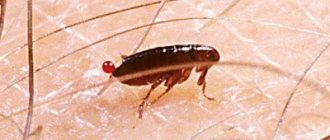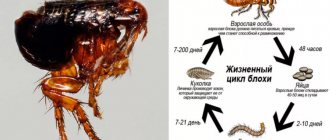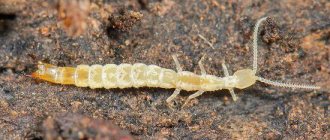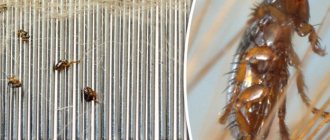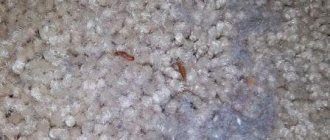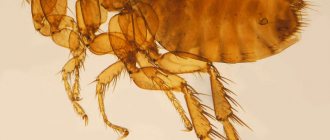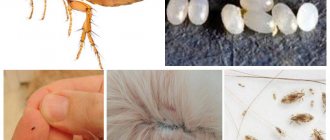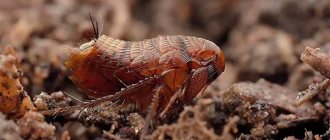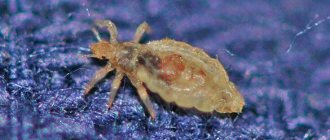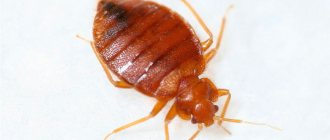Most often, pet owners encounter fleas. As a rule, they do not attach much importance to all the dangers that these insects cause to pets and people. Some people believe that dog or cat fleas do not attack people, but this is not true. In this article we will talk in detail about the existing types of fleas, their lifestyle and habitat, as well as the harm they can cause to people and animals. Here are tips on how to get rid of fleas in the house on your own using insecticides or traditional methods. Schoolchildren will be able to find many interesting points for writing an essay about fleas.
Description of fleas: lifestyle, body structure
Fleas belong to the order of blood-sucking arthropods. The length of the parasite can reach 5 mm, females after feeding grow up to 1 cm, fertilized ones - up to 1.5 cm. The body of the flea consists of a head and abdomen covered with chitinous cover, the body is flattened on the sides. Thanks to this shape, the insect easily moves among feathers, fur and clothing. Color ranges from yellow to almost black.
Interesting! During the process of evolution, many animals have changed in appearance. Scientists have found that the modern flea looks almost the same as its ancestors.
Fleas do not have wings, and they move by jumping with the help of three pairs of long and strong limbs. Some species have shorter paws, so they are constantly on the host's body. The paw consists of five segments and ends with sharp bristles-claws, forked at the end.
The flea's body is covered with spines and bristles, which helps it move very quickly throughout the victim's body. The head has serrated ridges. Due to this structure, the parasite cannot be combed out, chewed out or removed; it can only be crushed with a fingernail.
At the back of the abdomen is the pygidium, a sensory organ covered with tactile hairs. They react to small changes in air and warn of danger.
The reproductive system of the female consists of the oviduct, ovaries and spermatic receptacle (in the shape of a curved flask), and of the males - the genital claw (copulatory organ).
There are antennas behind the eyes. With them, males hold onto females during mating. The rest of the time they are in the antennal fossae.
The type of oral cavity is piercing-sucking. After biting the skin, the flea enlarges the wound, secretes saliva, which prevents blood clotting, then penetrates deeper and moves to the blood vessel, where it sucks blood. A flea cannot crawl completely under the skin.
Spreading
Fleas are found everywhere. Adult insects are found even in Antarctica! However, a temperate and subtropical climate is considered optimal for them. In these latitudes they are especially common and thriving. The largest populations of insects are found in Asia, Africa and South America. Insects that parasitize cats and dogs are found throughout the globe. Only in Australia are fleas found that feed on the blood of marsupials.
Fleas have no special preferences regarding the choice of terrain. They thrive in the forest zone, parasitizing mammals and birds, in the steppes, mountains, and swamps. Wherever there are warm-blooded creatures, these parasites can be found. The spread is greatly facilitated by people, transporting goods and animals from one point of the Earth to another. Insect populations also migrate with animals and migratory birds.
If your home has become a haven for these parasites, you must immediately begin the fight against them. You can learn how to do this from the article - How to remove fleas from an apartment: methods, methods and practical tips.
You can learn interesting facts about the life of fleas by watching this video:
Lifestyle and behavioral characteristics
Fleas can always be seen, regardless of the time of year, on the owner or in his home. The main carriers are mammals that have a nest, burrow or live in an apartment. Some types of fleas settle in nests left for a long time. Homeless animals do not have their own home, so their fleas live on their bodies all year round and breed there. Parasites suck blood, regardless of gender, from one minute to several hours. When food runs out, insects can live for a long time (months) without food, but then they attack the owner with greed.
Interesting! A flea's jump is about 100 times longer than its body length.
Interesting Facts
- In the 17th-18th centuries, fleas were so common among the French nobility that French aristocrats even had special items for catching fleas, so-called “flea traps,” which were small boxes like a medallion with a small hole into which fleas could accidentally fall.
- It was fleas that caused terrible epidemics of bubonic plague in the Middle Ages, which claimed many human lives. The plague fleas themselves were carried by rats and mice.
- Fleas are true jumping champions among insects; the length of a flea's jump can exceed the length of the flea itself by 100 times! Only cicadas jump further than fleas in relation to body length.
- The first serious scientific study of fleas began in the 19th century. A great contribution to their study was made by a certain Charles Rothschild, a wealthy English banker and part-time entomologist. He also collected the world's largest collection of various fleas, which is now kept in the British Museum.
Types of fleas
There are about 22 families of fleas, which include various species.
- The human flea is the most common species. A brown insect up to 3.2 mm long, jump height 30 cm, length 50 cm. It has no thoracic or head teeth. Sucks the blood of humans and animals. Carries plague pathogens and causes pulicosis. The blood is sucked for up to 20 minutes and digested for 6 hours.
- The cat flea infests all animals, even humans. Carries many infections. The larvae develop in animal fur and bedding. Body length is up to 5 mm, females are larger - up to 1.6 cm. They live up to two years.
- The dog flea lives on dogs, cats and humans. Carries flatworms and other parasites, is the keeper of the pathogens of plague, leprosy, and Marseilles fever. Size up to 5 mm, lives up to 1.5 years.
- The rat flea is recognized as the most dangerous species, carrying plague, mouse and rat tapeworm. The length of females is 2.7 mm, males - 2 mm. Color ranges from light brown to darker. Females lay eggs in rat nests.
- The Tien Shan flea, as the name suggests, lives in the Tien Shan. The fertilized female increases in length, which gives them a worm-like appearance. The length of males is 4 mm, females – 5 mm, color black. Fleas appear in winter, rising from the frozen ground onto the body of livestock. The insects soon become larger, changing color to white.
- The grass flea (up to 3 mm long) lives on trees, bushes, grass, and gets into the apartment with the help of pets. It differs from other species in the presence of wings.
- The penetrating flea (sand flea, Brazilian ground flea) is native to Haiti, Brazil. Length 1 mm, jump height up to 35 mm. The fertilized female becomes round with a diameter of up to 1 cm. Lives in dry grass, jumps on humans, birds and animals. Males drink blood, and females get under the skin of animals' legs or human nails, causing inflammation and tetanus, which leads to gangrene, amputation, and in some cases death.
There is a species called the bed flea, which lives on upholstered furniture and bed linen (another name for linen flea). They bite a person at night in the areas of the body with the thinnest skin.
Differences
Fleas are not as simple as they seem at first glance. Externally, representatives of different species are practically indistinguishable. The human eye sees only a small dark dot, which disappears from view as soon as someone tries to catch it. It is impossible to trace her movement . The tiny bloodsucker jumps high.
More than 2 thousand species of fleas are known. The most common among them are :
- human;
- clothing or bedding;
- felines;
- canine;
- rat;
- chicken
Almost every genus of mammals has its own parasite. Clothes, house or bed fleas more often live in the folds of clothing, fill space in the bed or hide in carpets and paths.
Fleas are white only at the larval stage. Then they have a worm-like shape. Flea larvae are not yet capable of biting and drinking blood . Therefore, while they grow up, they live closer to organic remains.
In addition to the varieties of fleas listed above, there are earth and grass fleas. From our materials you will learn what kind of insects these are and how to fight them, as well as how to detect and get rid of parasites in a parrot and hamster.
Where do fleas live?
Fleas live on all continents, including Antarctica, in nests and burrows, on the body of animals and humans. They are active at any time of the year.
The main hosts are warm-blooded mammals that have a home. If an animal lives in a burrow (nest), fleas attack it less often (only for feeding). Animals without shelter are a permanent habitat for parasites. Some species need to feed frequently, so they are always on the host's body. Ground fleas live closer to the floor (behind baseboards, on carpets), cat and dog fleas live on the pet’s bed.
Life cycle, reproduction and development of a flea
The life cycle of parasites consists of the following stages:
- egg;
- larva;
- chrysalis;
- imago (adult).
The most comfortable temperature for breeding is 18-25 degrees (then they breed all year round). In cold weather they live but do not reproduce. Before mating, partners eat. The female climbs onto the male's back and takes the genital claw into the spermatic receptacle. Mating lasts several hours, and the seed moves into the female’s body within 15 minutes.
Eggs are laid in small portions. The female ejects small white eggs from her body; they are located quite far from each other. After two weeks, they hatch into translucent larvae without legs, similar to worms. They make their way inside the nest and feed on rotting organic matter, skin epithelium, and blood residues from the excrement of their parents. After three molts, the larva becomes a pupa (it wraps itself in a silk-like cocoon). This stage lasts from 5 days to several months (it depends on the climate). When a flea emerges from a pupa, it immediately looks for its owner.
Lifespan
How long do fleas live? The lifespan of a flea depends on its species and habitat, and can range from several months to three years. At elevated temperatures, when the air temperature is more than 30 C, the life cycle of the blocks is reduced by 40%. And at lower temperatures, the life expectancy of a flea, on the contrary, increases as its development slows down.
How long do fleas live without an animal or, in general, without a donor? Being outside the animal's body, the flea remains without food, but since these insects are capable of not feeding for a long time, the flea easily tolerates hunger for 30-40 days. At the same time, it can live for several months, although such a starving flea reduces its activity and stops reproducing.
The danger of fleas to humans and animals
The main danger of insects is the various infections, bacteria and diseases they carry. In the body of some species there are more than two hundred viruses and bacteria that cause fatal diseases. In addition, an allergy to flea enzymes with characteristic symptoms (inflammation, itching, fever) may develop.
What diseases are carried
Fleas can infect humans with pulicosis and sarcopsillosis. They carry:
- plague;
- typhus;
- encephalitis;
- hepatitis;
- salmonellosis;
- fungal infections and others.
Fleas suck the blood of not only healthy organisms, but also sick and dead ones. Viruses enter the blood through a bite with saliva and spread throughout the body.
Interesting! In the Middle Ages, the bubonic plague claimed the lives of many people. The source of the disease was fleas, which were brought along with rats on ships.
Why are insects dangerous?
Pathogenic microflora that entered the parasite's body with the blood of the previous owner can remain in the flea's mouth and saliva. Further insect bites lead to the spread of infection.
They can act as carriers:
After a flea bite, hives on the skin may occur.
- typhus;
- plague;
- anthrax;
- encephalitis;
- hepatitis A;
- tularemia;
- tuberculosis;
- listeriosis.
Infection with helminths is also possible. In addition, injecting saliva into a wound on a person’s skin can cause the development of individual reactions. The most common symptoms that occur after bites are urticaria and dermatitis.
In rare cases, a person experiences a migraine, enlarged lymph nodes, sleep disturbances, and a rise in temperature.
How do fleas bite humans?
The flea pierces the skin when it bites, causing stabbing pain and unbearable itching. At the same time, it does not secrete an anesthetic substance, but introduces enzymes that prevent blood clotting. Since the parasite does not have a proboscis like mosquitoes, it has to penetrate the layer of skin to reach a blood vessel. The bite site swells as if from a cigarette burn. After the fleas are saturated, the wounds converge, which prevents blood from escaping.
Each person reacts to a bite differently. For some, the itching goes away quickly, while for others, signs of inflammation persist for several days. With pulicosis, the skin swells, ulcers appear on the oral mucosa, and the central nervous system is affected. An allergic reaction to human bites causes fever, chills, and indigestion.
It is possible to defeat parasites!
Antiparasitic Complex® - Reliable and safe removal of parasites in 21 days!
- The composition includes only natural ingredients;
- Does not cause side effects;
- Absolutely safe;
- Protects the liver, heart, lungs, stomach, skin from parasites;
- Removes waste products of parasites from the body.
- Effectively destroys most types of helminths in 21 days.
There is now a preferential program for free packaging. Read expert opinion.
Read further:
What do mosquitoes eat, besides blood, females and males, in the swamp and in nature?
How to treat flea bites with pulicosis?
Advocate against worms and fleas for cats and dogs: instructions for use, price, reviews
Centipede mosquito. Description, stages of development. What do big mosquitoes eat? Whether they bite or not. Damage from long-legged mosquitoes
Long worms in dogs: main types, description and methods of treating parasites in dogs
How long does a mosquito live: life expectancy, after a bite, in an apartment
How can you tell if there are fleas at home?
House fleas are not separate species. This is the name given to insects that have settled in an apartment. They are not detected immediately. To determine whether there are insects at home or not, you can conduct an experiment. You need to spread a white sheet on the floor and look at it after some time. Dark insects are clearly visible against a light background. Another sign of the appearance of “uninvited guests” are bite marks on the human body - red, slightly swollen spots that appear in the morning and are very itchy.
How to get rid of it?
Parasites must be combated; modern drugs will help even in advanced cases. First you need to determine where the insects in the house come from. So, if fleas were brought by pets, they need to be treated. If parasites are coming from the basement or from neighbors, seal the existing cracks. To get rid of fleas at home, we recommend using modern insecticidal preparations that do not have a pungent odor and do not harm people and pets.
Chemicals
Since a flea cannot eat the bait, insecticidal preparations are produced in the form of a spray, powder, or aerosol. All means affect the nervous system of the parasite and paralyze it.
- Aerosols will help when treating a large affected area. Be sure to evacuate all residents, after the procedure, ventilate the room and do wet cleaning.
- Powders are distributed in habitats and have a long-lasting effect.
- Liquid microcapsules are not washed out after cleaning.
The most popular and effective are:
- Raptor spray, marked “against crawling insects”, has a pleasant smell;
- Combat - spray, analogue of Raptor;
- Sinuzan is a professional product with a rather unpleasant odor;
- Chlorpirimark is suitable not only for removing fleas, but also the Colorado potato beetle;
- Biorin is a professional product that destroys all existing insects;
- Dust is especially effective against parasite larvae;
- Delcid is an emulsion intended for pets;
- Pyrethrum - powder scattered in corners, poisons parasites.
After killing the insects, you need to do a wet cleaning by adding ammonia or eucalyptus essential oil to the water. It is advisable to place branches of wormwood and lavender under the bed.
